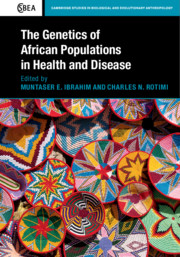Book contents
- The Genetics of African Populations in Health and Disease
- Cambridge Studies in Biological and Evolutionary Anthropology
- The Genetics of African Populations in Health and Disease
- Copyright page
- Contents
- Contributors
- 1 Reflections on Conceptualizing Africa for Biological Studies with a Historical Component
- 2 History and Genetics in Africa
- 3 Disease, Selection, and Evolution in the African Landscape
- 4 Genetic Susceptibility to Visceral Leishmaniasis
- 5 Genetics of Infection in Sub-Saharan Africa
- 6 Pharmacogenomics and Infectious Diseases in Africa
- 7 A Glimpse into Pharmacogenomics in Africa
- 8 Genomics of Cardiometabolic Disorders in Sub-Saharan Africa
- 9 Breast Cancer in African Populations
- 10 Sociobiological Transition and Cancer
- 11 The Genetic Epidemiology of Orphan Diseases in North Africa
- 12 Birth Defects and Genetic Disease in Sub-Saharan Africa
- 13 Neurogenetic Disorders in Africa: Hereditary Spastic Paraplegia
- 14 Enabling Genomic Revolution in Africa
- Index
- References
11 - The Genetic Epidemiology of Orphan Diseases in North Africa
Published online by Cambridge University Press: 02 December 2019
- The Genetics of African Populations in Health and Disease
- Cambridge Studies in Biological and Evolutionary Anthropology
- The Genetics of African Populations in Health and Disease
- Copyright page
- Contents
- Contributors
- 1 Reflections on Conceptualizing Africa for Biological Studies with a Historical Component
- 2 History and Genetics in Africa
- 3 Disease, Selection, and Evolution in the African Landscape
- 4 Genetic Susceptibility to Visceral Leishmaniasis
- 5 Genetics of Infection in Sub-Saharan Africa
- 6 Pharmacogenomics and Infectious Diseases in Africa
- 7 A Glimpse into Pharmacogenomics in Africa
- 8 Genomics of Cardiometabolic Disorders in Sub-Saharan Africa
- 9 Breast Cancer in African Populations
- 10 Sociobiological Transition and Cancer
- 11 The Genetic Epidemiology of Orphan Diseases in North Africa
- 12 Birth Defects and Genetic Disease in Sub-Saharan Africa
- 13 Neurogenetic Disorders in Africa: Hereditary Spastic Paraplegia
- 14 Enabling Genomic Revolution in Africa
- Index
- References
Summary
North Africa (NA) is defined as the northernmost geographical region of the African continent, linked by the Sahara from the south and separated from Europe by the Mediterranean Sea. It encompasses five countries from east to west: Egypt, Libya, Tunisia, Algeria, and Morocco; these are also known as Maghreb countries. From the political point of view, at the regional level, Mauritania is considered part of the Maghreb. The current population size is estimated to be around 75 million. A set of features affects markedly the prevalence and distribution of the genetic diseases in the region. The demographic features include high population growth rates, high birth rates, and high infant mortality rates. The family structure was as large as that of Arab families, with more than six children per woman until the middle of the twentieth century. Nowadays, North African (NAf) families show reduced rates of fertility that reach their lowest point at 1.06 children per decade in Tunisia (United Nations, Department of Economic and Social Affairs, Population Division, 2010).
- Type
- Chapter
- Information
- The Genetics of African Populations in Health and Disease , pp. 233 - 267Publisher: Cambridge University PressPrint publication year: 2019

